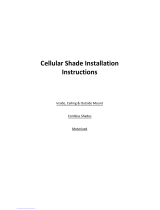
THE SHADE WILL NOT SNAP INTO THE INSTALLATION BRACKETS.
• Check that the installation brackets are aligned and level.
THE SHADE IS HARD TO RAISE OR LOWER, OR WILL NOT RAISE OR LOWER.
• Shades cannot be forced into tight inside mount window openings. If an inside mount, check that the shade is installed correctly.
Make sure there is clearance between the ends of the shade and the window casement.
• Check that the installation brackets are level. Shim to level, if necessary.
• If hold-down brackets are used, make sure they have been released.
• Make sure the fabric is not caught.
THE SHADE RAISES OR LOWERS UNEVENLY OR THE BOTTOM RAIL IS UNEVEN.
• Check that the window is square by measuring the diagonals.
• Check that the installation brackets are level. Shim to level, if necessary.
• Adjust the cords under the bottom rail (see “Adjusting The Shade” on page 6).
THE CORD TENSIONER GRABS ONTO THE CORD UPON OPERATION.
• Check that the cord tensioner is mounted properly. Reinstall, if necessary. Refer to the Universal Cord Tensioner Installation Instructions
included with your cord loop shade.
IMPORTANT INFORMATION REGARDING CORDLESS SHADE OPERATION.
• Daily operation of shade will ensure that it performs at its optimal level.
• If the shade is in the lowered position for an extended period of time, extra care needs to be taken when raising the shade. The fabric will
relax and may resist lifting. This is a natural occurrence with all fabric shades. When lifting, you may notice the billowing (falling out) toward
you. This is temporary and can be corrected by slowly raising the shade completely and then operating several times. This allows the fabric
to go back to its pleated state, and the shade will operate as designed.
• If shade has been in the fully raised position for an extended period of time, it may have a tendency to “spring back” above the desired length
of the shade. This is temporary and can be corrected by completely raising the shade and operating several times.
• Operating the shade with the handle(s) provided is recommended so that the shade is balanced when raising and lowering.
• Motorized Shades – see Operating Instructions Guide included with shade/remote control.
Honeycomb shades are made of an anti-static, dust resistant fabric which repels dirt and dust. For most of these fabrics, the following options are
available if your shade needs cleaning.
DUSTING: Regular light dusting with a feather duster is all the cleaning that is needed in most circumstances.
VACUUMING: Use a hand-held vacuum with low suction for more thorough dust removal.
SPOT CLEANING: Use the following steps for spot cleaning: (1) Prepare a solution of warm water and mild dish-washing detergent. (2) Dampen a
clean cloth in the solution and ring it out. (3) Dab the spot with the dampened cloth until it is gone. DO NOT RUB THE FABRIC. (4) Allow the shade
to dry in the completely lowered position.
CAUTION: Avoid creasing Blackout fabrics during cleaning.
DEEP CLEANING: Use the following steps for deep cleaning: (1) Immerse shade in basin or bathtub lled with warm water and mild detergent.
(2) Rinse with clean water. (3) Fully raise shade and tilt to eliminate excess water, (4) Reinstall damp shade, lower it, and let it dry completely.
CAUTION: Do not immerse Blackout fabrics. Do not immerse the headrail or any fabric-wrapped rail.
ULTRASONIC CLEANING: Standard shades, except those made with Blackout Lining can be ultrasonically cleaned by a professional.
• Specify that a mild detergent be used.
• Never immerse the headrail or any fabric-wrapped rail in the solution.
• Dry the shade completely in the lowered position.
CAUTION: Do not ultrasonically clean Blackout fabrics. Do not immerse headrail.
6
TROUBLESHOOTING
CARE AND CLEANING


















